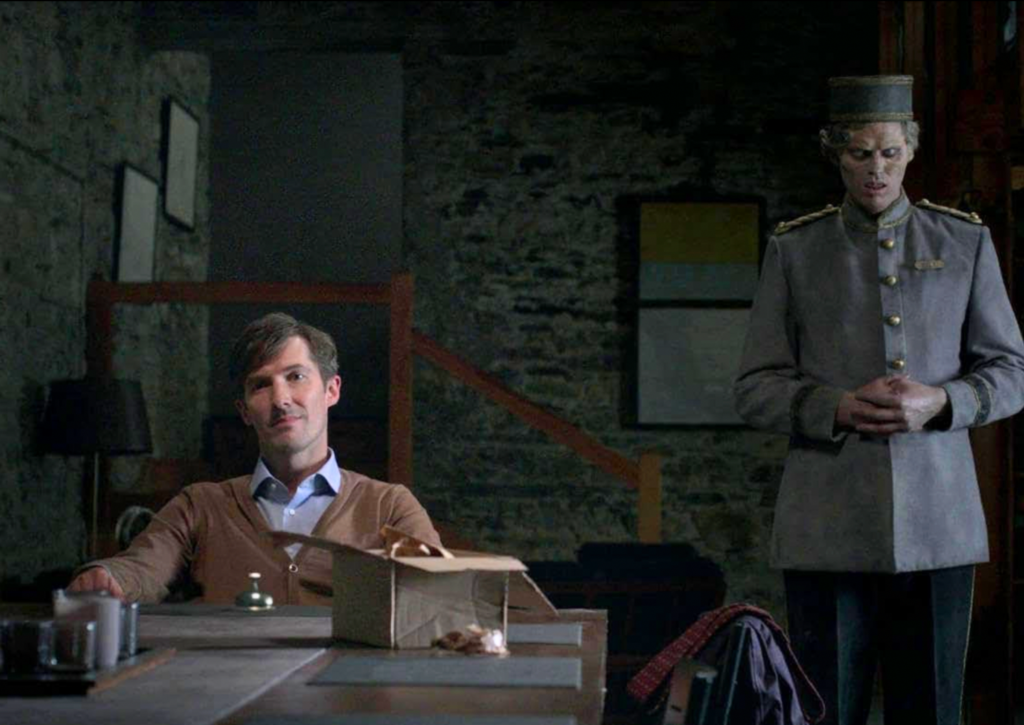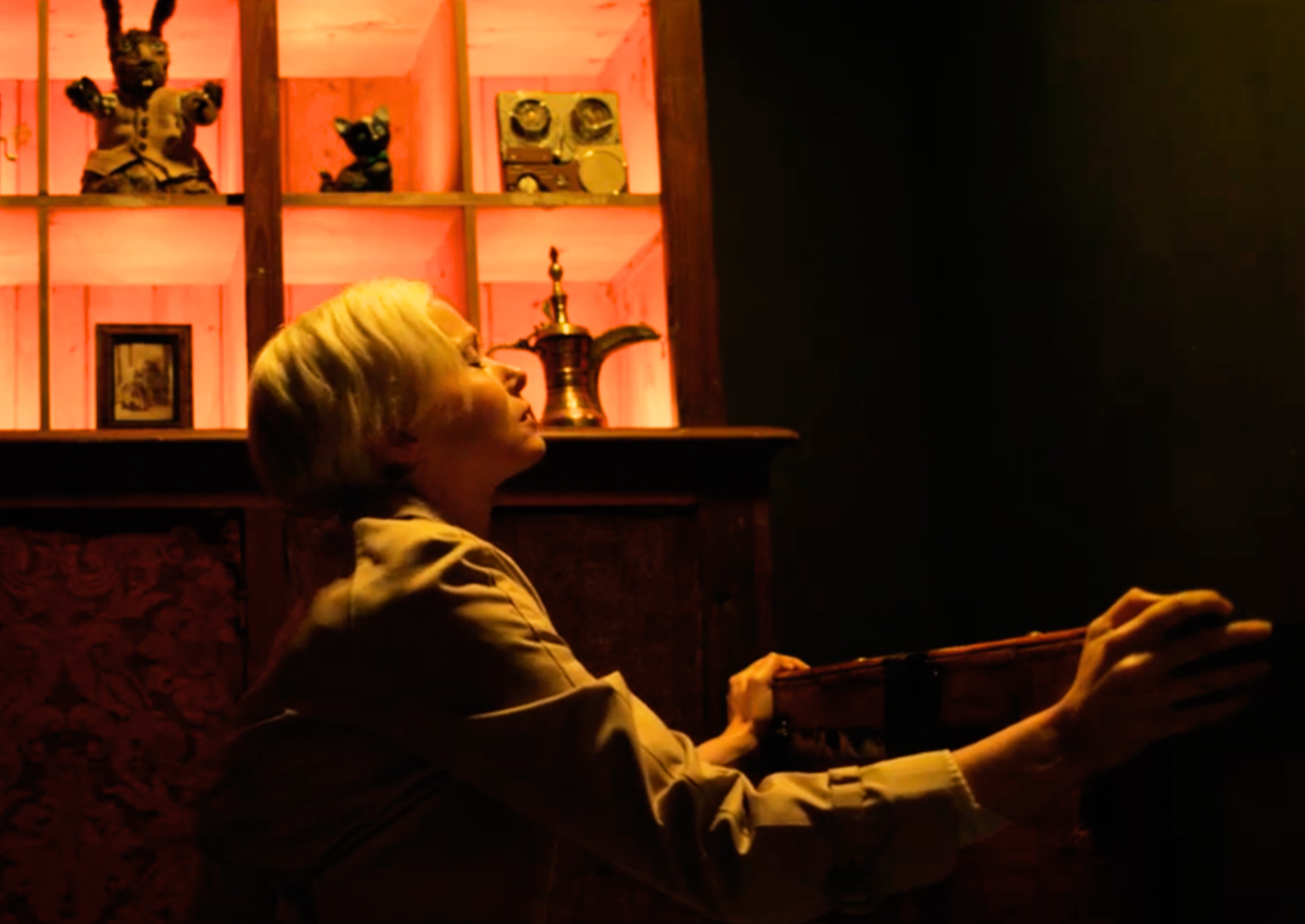This review contains spoilers from the film The Oddity (2024).
The Oddity (2024) rises above typical horror fare, defying genre clichés by blending chilling atmosphere, psychological depth, and biting social commentary.
Written and directed by Damian McCarthy, the film delves into themes of control, intuition, and hierarchy, creating a horror story rich with intellect and layered character dynamics that resonate well beyond the screen.
While horror fans have said the film is straightforward, I beg to differ.
The storyline is underpinned by an intriguing, parallel hierarchy structure that juxtaposes two sets of characters, with each group being comprised of three characters.
On one side, we have Dr. Ted Timmis (Gwilym Lee), his subordinate Ivan (Steve Wall), and a feral, psychotic patient.
Meanwhile, on the ‘good’ side, there’s the doctor’s late wife Dani Timmis and her blind, identical twin sister Darcy, both played by Carolyn Bracken. Darcy also keeps a mysterious “wood man” effigy in a creepy antique chest (because, where else?), that she brings with her to visit Dr. Timmis after her sister’s unsolved murder.
This mirroring between the two groups evoke a symbolic hierarchy that plays with Freudian ideas of superego, ego, and id, particularly against the backdrop of a mental institution. These characters are personifications of each psyche complex and their relationships to each other.
Freudian Allegory
For context, and in a nutshell:
- The id is the primal part of our personality that seeks immediate gratification and operates on the pleasure principle.
- The ego mediates between the id’s desires and reality, making rational decisions.
- The superego embodies moral standards and ideals, imposing guilt and reward relating to ethics and morality.
In one scene, we see Dr. Timmis (the superego) coldly and matter-of-factly enlisting Ivan to kill his wife Dani. Ivan—the ego mediating the superego and id—asks, “why don’t you just divorce her?”
The doctor tells Ivan he risks losing his house if Dani finds about Yana. But to add some “morality basis” for the request, the doctor also adds “She loves me. She’ll never get over me…this is the only way.”
Accepting the doctor’s rationale, Ivan also starts negotiating on behalf of the id.
“What if the motive was sexual? It happens all the time,” Ivan pitches the doctor. “The adrenaline kicks in. You have your hand on their throat…”
After some insistence, the doctor shuts Ivan’s id-centric proposal down—as though he is imposing morality in some perverse way, despite the larger context of the conversation.
“I don’t want her hurt. Just dead,” he says.
In parallel, on the feminine side, the ghost of Dani frightens Yana out of the house. Her twin Darcy (ego) is there to avenge Dani’s death, but Dani, the moral compass (superego) on the feminine side, appears to Yana several times, causing Yana to flee.
Despite the indirect role she plays in Dani’s death, Yana is spared. Not just from Darcy’s revenge mission, but from what the doctor’s god complex may decide for her in the future. In doing so, Dani arguably saves Yana’s life—an act of morality considering the context.
Dismissal of Feminine Intuitive Power
The twins embody a feminine, intuitive insight, seeming to access truths beyond the ordinary through an almost otherworldly awareness.
Darcy’s blindness underscores this theme: Without sight, she has an enhanced intuition that enables her to “see” how her sister’s death actually happened and identify Timmis as the killer, despite an investigation falsely incriminating one of Dr. Timmis’s patients.
Though it is later revealed that Darcy is right, because of the way she becomes aware of the truth, her revelations are all-too easy to dismiss. Despite being most in tune with the truth, her mental state and reality are brought into question.
In contrast, the doctor epitomizes a rigid adherence to “objective reality” and external authority, personifying a form of masculinity that deftly, effortlessly, and without resistance, masks his underlying deception. Most importantly, the doctor has the authority to decide what is real and what is not, a power he exercises regularly in a self-serving way.
Dr. Timmis believes himself to be objectively perceptive. “There’s nothing that can’t be explained,” the doctor says. He is confidently dismissive of the twins’ esoteric, intuitive powers. “Dani used to say that one of her goals was to open that closed mind of yours,” Darcy tells him in their confrontation.
Despite being the most destructive and manipulative character, Timmis has the authority and societal trust to dismiss the experiences and realities of others or conform them into a reality that suits him. His perceived objectivity and inherent authority enables him to be the most manipulative character of all.
Real World Oddity
The Oddity illustrates the power imbalance between genders, pitting external, tangible perception against internal, ethereal intuition.
It draws a fascinating line to real-life subordination of the feminine intuition to the masculine perception of the world.
The asylum setting echos centuries of institutional dismissal of the feminine experience as “crazy,” hysterical,” applying Freudian ideas and blind egoism at the same time. But like Dr. Timmis, Freud didn’t have the capacity to analyze his own shortcomings or consider blind spots in his perception of reality. He sees himself as the arbitrator of reality, both for himself and those around him.
Also like Dr. Timmis, historians have speculated that Freud had an affair with his wife’s younger sister. Meanwhile, Freud categorically dismissed female patient’s memories of early childhood trauma as imaginary fantasies and repressed desires, which he viewed as a precursor to hysteria.
Freud, like Dr. Timmis, assumes that what he cannot perceive, experience, or understand, must not be real, and can only understand the experiences of others as a function towards his own self interest.
Historically, men were able to have their wives committed, often for becoming what they saw an inconvenience in much the same way Timmis views Dani after he begins his affair with Yana.
In The Oddity, pathologizing others’ experiences becomes a tool to mask selfish intentions, creating dissonance between these motives, their destructive impact, and accountability.
The result is a powerful reminder of the horror genre’s ability to confront real-world, codified dynamics wrapped in supernatural terror.
The Downfall of the Superego
The doctor, whose hubris renders him dismissive of spiritual warnings, is also the catalyst of his own presumed demise.
After all, he is the one who delivers Olin Boole’s eye to Darcy, who uses it to literally able to see what happened to her sister and identify Timmis as the real killer. Had the doctor not fulfilled this request for Darcy, Boole’s guilt would not have been questioned.
Viewers are left with a subtle, climactic detail involving a hotel service bell that the doctor saw Darcy holding when he came to give her Odin’s eye.
At the time, Darcy tells the doctor of the bell’s backstory involving a hotel bellboy who was killed by a violent customer.
“It’s not something to be played with, Ted,” Darcy tells him. “The last two people who rang this bell were found dead.
Prior to her death, Darcy sends the bell to the doctor’s house in a package. Upon receiving it, the doctor is initially hesitant to ring it. But his ego gets the best of him, so he rings it, chuckling at his own momentary hesitation.
The final scene shows the doctor sitting smugly at the table, confident in his skepticism. Behind him stands the dead bell boy, implying his fate is sealed.

Oddity Lands with Horror Fans
The Oddity has a couple well-placed jump scares, but the real spooks come from the mounting psychological tension. Its a slow-burn horror, a welcome addition to the genre. Its creepy without sacrificing intelligence, suspenseful without relying on over-the-top twist endings.
Despite a lackluster box office debut, The Oddity has been praised by horror fans, landing a 96% favorable rating on Rotten Tomatoes.
The film is often cited in Reddit’s 3 million member horror community as one of the best horror films of the year.
This article is for informational purposes only. Trendy Matters has no affiliation with any of the brands or individuals mentioned, and the views expressed in this article are solely those of the author.


